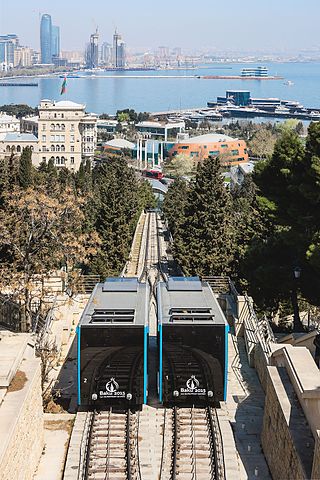
A funicular is a type of cable railway system that connects points along a railway track laid on a steep slope. The system is characterized by two counterbalanced carriages permanently attached to opposite ends of a haulage cable, which is looped over a pulley at the upper end of the track. The result of such a configuration is that the two carriages move synchronously: as one ascends, the other descends at an equal speed. This feature distinguishes funiculars from inclined elevators, which have a single car that is hauled uphill.
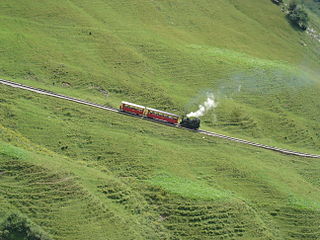
A mountain railway is a railway that operates in a mountainous region. It may operate through the mountains by following mountain valleys and tunneling beneath mountain passes, or it may climb a mountain to provide transport to and from the summit.

A rack railway is a steep grade railway with a toothed rack rail, usually between the running rails. The trains are fitted with one or more cog wheels or pinions that mesh with this rack rail. This allows the trains to operate on steep gradients of 100% or more, well above the 10% maximum for friction-based rail. The rack and pinion mechanism also provides more controlled braking and reduces the effects of snow or ice on the rails. Most rack railways are mountain railways, although a few are transit railways or tramways built to overcome a steep gradient in an urban environment. The first cog railway was the Middleton Railway between Middleton and Leeds in West Yorkshire, England, United Kingdom, where the first commercially successful steam locomotive, Salamanca, ran in 1812. This used a rack and pinion system designed and patented in 1811 by John Blenkinsop.

The grade (US) or gradient (UK) of a physical feature, landform or constructed line refers to the tangent of the angle of that surface to the horizontal. It is a special case of the slope, where zero indicates horizontality. A larger number indicates higher or steeper degree of "tilt". Often slope is calculated as a ratio of "rise" to "run", or as a fraction in which run is the horizontal distance and rise is the vertical distance.

The Broadmoor Manitou and Pikes Peak Cog Railway is a cog railway that climbs one of the most iconic mountains in the United States, Pikes Peak in Colorado. The base station is in Manitou Springs, near Colorado Springs.

The Rimutaka Incline was a 3-mile-long (4.8 km), 3 ft 6 in gauge railway line on an average grade of 1-in-15 using the Fell system between Summit and Cross Creek stations on the Wairarapa side of the original Wairarapa Line in the Wairarapa district of New Zealand. The term "Rimutaka Incline" is sometimes used incorrectly to refer to other parts or all of the closed and deviated section of the Wairarapa Line between Upper Hutt and Speedy's Crossing, near Featherston. The incline formation is now part of the Remutaka Rail Trail.

The Fell system was the first third-rail system for railways that were too steep to be worked by adhesion on the two running rails alone. It used a raised centre rail between the two running rails to provide extra traction and braking, or braking alone. Trains were propelled by wheels horizontally applied and retracted by springs onto the centre rail, controlled from the cab, as well as by the normal running wheels. In practice, the running wheels could be allowed to run freely to reduce wear, but the centre brake shoes needed to be replaced frequently. For example: the locomotives' shoes were replaced after each journey on the Mont Cenis Pass Railway. Extra brake shoes were fitted to specially designed or adapted Fell locomotives and brake vans, and for traction the prototype locomotive had an auxiliary engine powering the horizontal wheels. The Fell system was developed in the 1860s and was soon superseded by various types of rack railway for new lines, but some Fell systems remained in use into the 1960s. The Snaefell Mountain Railway still uses the Fell system for (emergency) braking, but not for traction.

The São Paulo Railway Company was a privately owned British railway company in Brazil, which operated the 1,600 mm gauge railway from the seaport at Santos via São Paulo to Jundiaí. The company was nationalised in 1946 and became the Estrada de Ferro Santos-Jundiaí.

The Nilgiri Mountain Railway (NMR), colloquially called the "Toy Train" by locals is a 1,000 mmmetre gauge railway in Nilgiris district, Tamil Nadu, India, built by the British in 1908. The railway is operated by the Southern Railway and is the only rack railway in India.

The Pilatus Railway is a mountain railway in Switzerland and the steepest rack railway in the world, with a maximum gradient of 48% and an average gradient of 35%. The line runs from Alpnachstad, on Lake Alpnach, to a terminus near the Esel summit of Pilatus at an elevation of 2,073 m (6,801 ft), which makes it the highest railway in the canton of Obwalden and the second highest in Central Switzerland after the Furka line. At Alpnachstad, the Pilatus Railway connects with steamers on Lake Lucerne and with trains on the Brünigbahn line of Zentralbahn.
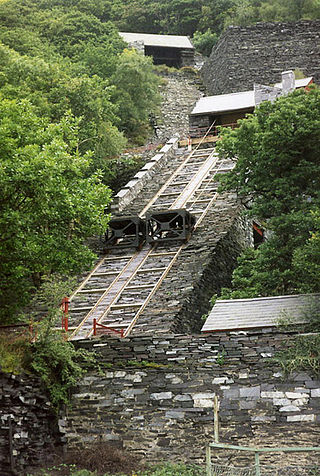
A cable railway is a railway that uses a cable, rope or chain to haul trains. It is a specific type of cable transportation.
The term ruling grade is usually used as a synonym for "steepest climb" between two points on a railroad. More simply, the steepest grade to be climbed dictates how powerful the motive power must be in order for the run to be made without assistance. Even if 99% of the line could be run with a low-powered locomotive, if at some point on the line there is a steeper gradient than such train would be able to climb, this gradient "rules" that a more powerful locomotive must be used, in spite of it being far too powerful for the rest of the line. This is why special "helper engines" are often stationed near steep grades on otherwise mild tracks. It is cheaper than running a too-powerful locomotive over the entire track mileage just in order to make the grade, especially when multiple trains run over the line each day.
The South Devon Banks are a series of steep inclines on the ex-GWR railway line linking Exeter and Plymouth in Devon, England. These two cities are separated by the rocky uplands of Dartmoor forcing the early railway surveyors to propose that the line skirt the difficult terrain of the comparatively sparsely populated moorland. Isambard Kingdom Brunel, in surveying the South Devon Railway, opted to push a line along a coastal strip between the Exe and Teign valleys, and then to climb the southern outliers of Dartmoor making for the head of the Plym estuary. From Newton Abbot, the line climbs Dainton Bank, and from Totnes it climbs Rattery Bank, reaches a peak at Wrangaton summit, and then descends Hemerdon Bank to reach Plymouth. These three are collectively known as the South Devon Banks.

The Düsseldorf–Elberfeld railway is a 27 km long main line railway in Germany, originally built by the Düsseldorf-Elberfeld Railway Company, connecting Düsseldorf and Elberfeld via Erkrath, Hochdahl and Vohwinkel. It is served by Regional Express, Regionalbahn and S-Bahn trains.

Mount Morgan railway station is a heritage-listed railway station at Railway Parade, Mount Morgan, Rockhampton Region, Queensland, Australia. It is on the Mount Morgan–Wowan railway line. The station was constructed in 1898 to service the former goldrush and gold mining township of Mount Morgan and its mine. The station was designed by Henrik Hansen, who also designed the Archer Park, Shorncliffe and South Brisbane railway stations. The station operated as a functional railway station from 1898 until 1987, after which it was restored as a Railway Heritage Museum. The museum includes artefacts from the rail and mining history of Mount Morgan, including a restored Hunslett steam engine, "Silver Bullet" rail motor and timber rail carriages. The station was added to the Queensland Heritage Register on 21 October 1992.
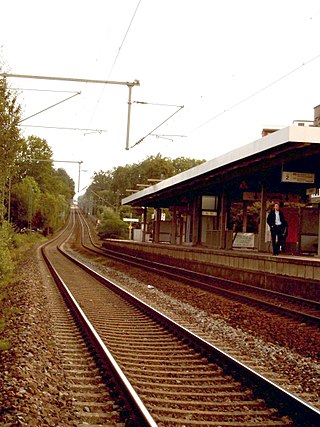
Erkrath station is a through station in the town of Erkrath in the German state of North Rhine-Westphalia. It has two platform tracks and it is classified by Deutsche Bahn as a category 5 station.
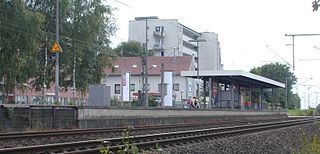
Hochdahl station is a through station in the district of Hochdahl of the town of Erkrath in the German state of North Rhine-Westphalia. It has two platform tracks and it is classified by Deutsche Bahn as a category 5 station.

An inclined elevator or inclined lift is a form of cable railway that hauls rail cars up a steep gradient.
A steep grade railway is a railway that ascends and descends a slope that has a steep grade. Such railways can use a number of different technologies to overcome the steepness of the grade.














